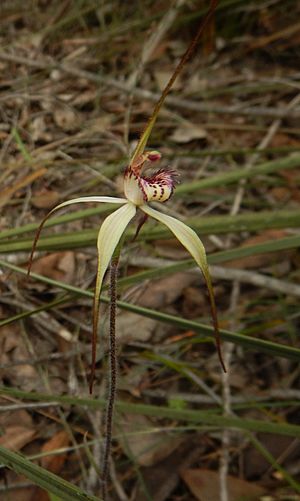Winter spider orchid facts for kids
Quick facts for kids Winter spider orchid |
|
|---|---|
 |
|
| Conservation status | |
| Scientific classification | |
| Genus: |
Caladenia
|
| Species: |
brumalis
|
The Caladenia brumalis, also known as the winter spider orchid, is a special type of plant in the orchid family. It grows only in South Australia, which means it is endemic there. This orchid has a straight, hairy leaf and usually one flower that can be white or pinkish with darker patterns. Because its natural home is shrinking, the winter spider orchid is now considered a vulnerable plant.
Contents
What Does the Winter Spider Orchid Look Like?
The winter spider orchid is a plant that grows on the ground. It is a perennial herb, which means it lives for more than two years. It also loses its leaves each year, like a deciduous tree. This orchid has a special underground part called a tuber, which helps it store food.
Leaves and Stems
From the tuber, a single, hairy leaf grows straight up. This leaf is shaped like a spear, about 4 to 8 centimetres (1.6 to 3.1 inches) long. It is also about 9 to 11 millimetres (0.35 to 0.43 inches) wide. The flower grows on a stem that is usually 12 to 20 centimetres (4.7 to 7.9 inches) tall.
The Flower's Appearance
The flowers of the winter spider orchid are quite large, about 7 centimetres (2.8 inches) wide. They are usually white or pinkish and have darker stripes.
- The top part of the flower, called the dorsal sepal, is long and thin. It is 5 to 7.5 centimetres (2.0 to 3.0 inches) long. Its tip looks like a thread and has many tiny black glands.
- The two side sepals are also long, about 5 to 6.5 centimetres (2.0 to 2.6 inches) long. They are wider at the base and also narrow into a thread-like tip.
- The petals are similar to the side sepals but a little shorter and narrower.
- The most interesting part is the labellum, which is the orchid's special lip. It is whitish or pinkish and sometimes has red marks. The labellum is about 14 to 16 millimetres (0.55 to 0.63 inches) long and 8 to 10 millimetres (0.31 to 0.39 inches) wide. It has parts that stand up on the sides.
- There are also small bumps called calli on the labellum. Some are about 2 millimetres (0.079 inches) long on the sides. Many other short, white-tipped calli run along the middle of the labellum.
This orchid usually blooms in August and September, which is late winter in Australia.
How the Winter Spider Orchid Got Its Name
The Caladenia brumalis was first officially described in 1991 by a botanist named David L. Jones. He found a sample of the orchid near Port Victoria, South Australia. The description was then published in a scientific book called Australian Orchid Research.
Meaning of the Name
The second part of its scientific name, brumalis, comes from a Latin word. It means "of the shortest day" or "wintry." This name was chosen because the orchid flowers in late winter.
Where the Winter Spider Orchid Lives
This type of caladenia orchid grows in specific places in South Australia. You can find it in woodlands, mallee (a type of bushland), shrubland, and sedgeland. These areas are usually close to the coast, near the city of Adelaide and on the Eyre and Yorke Peninsulas. It is known that many more flowers grow after a bushfire.
Protecting the Winter Spider Orchid
The Caladenia brumalis is listed as "vulnerable." This means it is at risk of disappearing if we don't protect it. Both the Australian Government, under the Environment Protection and Biodiversity Conservation Act 1999, and the South Australian government, under the National Parks and Wildlife Act 1972, have laws to protect it.
Threats to the Orchid
The biggest dangers to the winter spider orchid are:
- Loss of Habitat: Its natural homes are being destroyed or changed.
- Grazing: Animals eating too many of the plants.
- Weed Invasion: Other plants, called weeds, growing and taking over its space.


